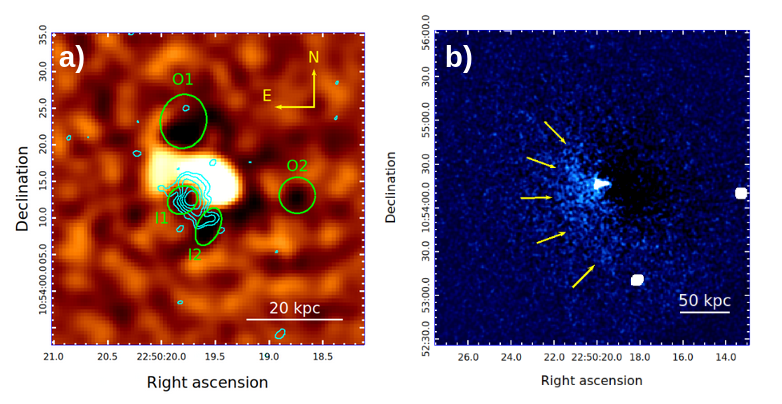Authors: Luca Rosignoli, Francesco Ubertosi, Myriam Gitti, Fabrizio Brighenti, Thomas Pasini, Ewan O’Sullivan, Fabio Gastaldello, Massimo Gaspari, Pasquale Temi
First Author’s Institution: Dipartimento di Fisica e Astronomia (DIFA), Università di Bologna, Italy and Istituto Nazionale di Astrofisica (INAF), Italy
Status: Submitted to ApJ [open access]
Galaxy clusters are the biggest gravitationally-bound objects in the universe. They’re made of three main components: galaxies, surrounded by a dark matter (DM) halo, and connected by hot gas known as the intracluster medium (ICM). It’s the interaction between these components that makes galaxy clusters so interesting, and also (we think) significantly affects galaxy formation and evolution as a whole. As an example of this interaction: many galaxy clusters have a supermassive black hole inside their central galaxy (known as a brightest cluster galaxy, or BCG) that’s acting as an Active Galactic Nucleus (AGN) – it’s being fed so much material by the galaxy and the cluster that it can’t contain it all, and it’s spitting material and energy back out into the cluster.
Thanks to gravity, each of these three components in a galaxy cluster should be centered around the same point in space – the dark matter forms a kind of gravitational ‘pit’ that both the ICM and the galaxies themselves can’t help but be pulled into. Other forms of energy (like heat keeping the ICM puffed out, or leftover kinetic energy keeping the galaxies orbiting) prevent the ICM and galaxies from collapsing entirely into the center of the pit, but they’re still definitely centered around where the pit is deepest. It’s very interesting, therefore, when the mass centers in galaxy clusters aren’t fully lined up. In today’s paper, the authors explore one of these cases.

A Misaligned Galaxy Cluster
This cluster, called Abell 2495, has been known about for a long time — it was discovered in 1998 through an x-ray search for clusters using the ROSAT satellite. Since then, a very wide variety of different data has been collected about this cluster in many different wavelengths, tracing different components of the cluster. The data that are most relevant here are radio data from the Expanded Very Large Array at 5 GHz frequencies (tracing activity from the AGN inside the central BCG), and optical images (showing the positions of the galaxies in the cluster) from the Hubble Space Telescope.
In addition to the ROSAT observations used to discover the galaxy cluster, there were previous Chandra observations of Abell 2495. However, both had a very low sensitivity, making it difficult to distinguish any features in the x-ray emitting gas. The authors present six new Chandra observations in this paper, vastly improving the sensitivity of the x-ray observations (which trace the hot gas of the ICM). Figure 1 combines several of these different types of observations, plotting them together as contours. X’s mark the various centers of the galaxy cluster components.
A Gassy History
In order to understand why the galaxy cluster isn’t centered properly, we need to look back at the history of its movements. Luckily, there’s an easy way to do that – the ICM in a cluster is normally smooth and symmetric, but it takes a while to settle after disturbances. This means that the x-ray light contains signatures of any strange happenings in the cluster’s recent history. The authors’ new Chandra observations are thus perfect for finding out what’s going on in Abell 2495.
Some of the more interesting features the authors found in the x-ray observations are shown in Figure 2. The four cavities (the dark regions in 2a) are indicators that the AGN inside the BCG of Abell 2495 had periods in the past where it was extra-active, emitting enough energy to blast holes into the ICM. What’s particularly interesting is how some of these cavities line up with the current position of the emission from that AGN (shown with the blue contours). The authors also found a significant density jump on one side of the ICM (the light region in Figure 2b), suggesting some force has piled up the gas on one side of the cluster in a dense cold front.


Finally, the authors bin up their x-ray image in 2-D space, so they can use the spectra of the x-rays to calculate the temperature of the ICM gas in each bin. Figure 3 shows the resulting temperature map. The regions of the map outlined in black have gas temperatures below a key threshold that means it can likely condense enough to fuel the AGN in the center of the cluster. This also means that the cluster is cool-core (see an astrobite about this here). Interestingly, there’s also an extended tail of cold ICM spiraling away from the center of the cluster, in a position that almost lines up with the cold front discussed above.
The Cosmic Bathtub
The authors of this paper believe that all of this evidence points to one very interesting phenomenon – the galaxy cluster is sloshing. This is a phenomenon that’s appeared widely in simulations, and has also been observed several times. It happens when some gravitational disturbance, typically a small ‘sub-cluster’ of galaxies, passes by the cluster. This disturbance pulls both the DM and the ICM in its direction through gravity, but the DM can pass right through anything in its way, while the ICM collides with other ICM creating cold fronts, so the two components get separated. This results in offsets between the centers, just like the ones observed in Abell 2495! As the disturbance passes, the DM and ICM falls back towards the center of the cluster, setting up an oscillation just like water sloshing in a bathtub.
The Scientific Relevance of Baths
The reason why sloshing is so fascinating is because the authors believe it could be regulating AGN feedback. Normally, galaxy clusters act around the feedback cycle described in the introduction – the ICM cools and collapses onto the AGN, which in turn gets extra active and heats the ICM back up again. In this case, however, the authors believe that the sloshing in this galaxy cluster is driving the whole feedback cycle. There is some quantitative evidence for this – the time the cluster takes to slosh is fairly consistent with the time between the formation of the different cavities in the ICM, and the size of the x-ray cavities is consistent with the amount of energy that would be involved. If this is the case, sloshing could drive the whole life cycle of the cluster.
Sloshing Towards the Future
The authors have done a lot of analysis to come up with these findings, but there are some limitations in the data that mean significant uncertainties remain. Better x-ray data could uncover more details about the x-ray cavities, helping to narrow down when they were formed and how much energy was required to create them. A clearer picture of the cold front would allow the ICM in the cluster center to be examined in more detail. It would also be helpful to get a larger sample of clusters with AGN feedback potentially regulated by sloshing – is this a common process, or is this cluster just very unique? Either way, this is a fascinating addition to our picture of one of the most extreme places in the universe – the center of a galaxy cluster.
Astrobite edited by Lina Kimmig
Featured image credit: ESA/Hubble





So interesting! I have never heard of the sloshing of galaxy clusters before! I read the published paper as well and you broke everything down very nicely, so thank you very much!